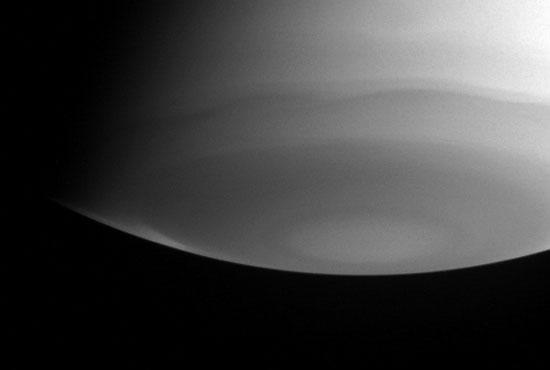Wavy bands in Saturn's high atmosphere lazily circle the south polar region in this Cassini image, taken through a filter sensitive to ultraviolet light.
At these wavelengths, gas in the atmosphere scatters sunlight more than the particles that make up the clouds, so the clouds look dark. This scattering of short-wavelength light by gas molecules is called Rayleigh scattering, and is the phenomenon that makes Earth's sky look blue.
The bright wedge near the lower-left limb of the planet falls in a latitude band just south of the dark `polar collar'. Imaging scientists can discern from this image that the stratosphere in this more southerly latitude band is relatively pure hydrogen and helium and contains very little of the stratospheric haze that causes darkening closer to the pole.
This image was taken with the Cassini spacecraft narrow angle camera on Aug. 27, 2004, at a distance of 9 million kilometers (5.6 million miles) from Saturn. The image scale is 108 kilometers (67 miles) per pixel.
The Cassini-Huygens mission is a cooperative project of NASA, the European Space Agency and the Italian Space Agency. The Jet Propulsion Laboratory, a division of the California Institute of Technology in Pasadena, manages the Cassini-Huygens mission for NASA's Science Mission Directorate, Washington, D.C. The Cassini orbiter and its two onboard cameras were designed, developed and assembled at JPL. The imaging team is based at the Space Science Institute, Boulder, Colo.
For more information about the Cassini-Huygens mission, visit http://saturn.jpl.nasa.gov and the Cassini imaging team home page, http://ciclops.org .
Image Credit:
NASA/JPL/Space Science Institute

